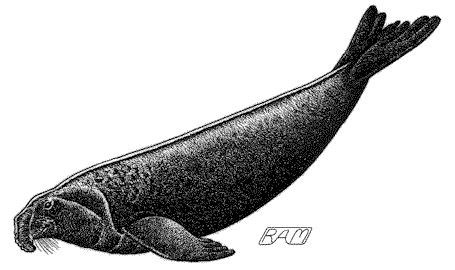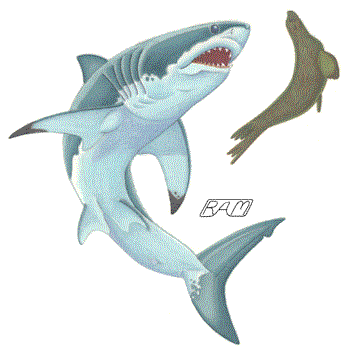Catch as Catch Can
Just as each of us must balance a household budget, predators must balance an energy budget. All of the multitudinous tasks that an organism needs to carry out in order to maintain itself must be accomplished within its energy budget. Everything an animal does is limited by the number of calories it takes in. Thus, it doesn't make sense for a predator to expend more calories in capturing a prey animal than can be extracted by digesting it. Predators - unlike nations - cannot operate at a deficit, at least not for very long. How do predators decide how to best expend their calories? Do they strive to 'economize' - minimize energy expenditures and maximize energy 'profits'? Why, from a group of similar potential prey organisms, does a predator choose one individual prey animal over another?
Theoretically, predators are in a powerful position to influence the populations of the prey organisms upon which they feed. There can be little doubt that predators are agents of natural selection, but little is known about how important they are in this regard. Even less is known about the role of individual choice in prey selection. There is ample evidence from field studies that predators tend to be opportunistic, but it is a gross oversimplification to suggest that they rely on prey that are sick, injured, or just plain stupid. There are very few 'free lunches' in Nature. In order to explore these complex and subtle issues of predatory strategy, let's take a look at the predatory strategies of one of the sea's paramount predators, the Great White Shark (Carcharodon carcharias).
 By
any standard, the Great White is an impressive creature. Growing to a
maximum length of at least 23 feet (7 metres) and a mass of more than two
tons (tonnes), the White Shark is some ten times larger than the 'average'
shark. But unlike the average shark, the Great White is also warm-bodied,
its swimming muscles averaging 9°F (5°C) warmer than the surrounding
seawater; warm-bloodedness affords some
spectacular advantages to a predator, but it also exacts a high energy cost.
One would think that this calorific tyranny would make the Great White a
kind of bottomless pit with fins, consuming anything and everything in its
path. But new evidence suggests that the White Shark is a cautious and
methodical predator that feeds relatively infrequently.
By
any standard, the Great White is an impressive creature. Growing to a
maximum length of at least 23 feet (7 metres) and a mass of more than two
tons (tonnes), the White Shark is some ten times larger than the 'average'
shark. But unlike the average shark, the Great White is also warm-bodied,
its swimming muscles averaging 9°F (5°C) warmer than the surrounding
seawater; warm-bloodedness affords some
spectacular advantages to a predator, but it also exacts a high energy cost.
One would think that this calorific tyranny would make the Great White a
kind of bottomless pit with fins, consuming anything and everything in its
path. But new evidence suggests that the White Shark is a cautious and
methodical predator that feeds relatively infrequently.
Only recently have we begun to understand how the White Shark feeds. Over the past 18 years, Scott Anderson and other biologists at the Point Reyes Bird Sanctuary on South Farallon Island (off San Francisco) have been keeping records of White Shark predation events. Attacks on California Sea Lions, Northern Fur seals, elephant seals, pelicans, and even a diver have been recorded off South Farallon. The vast majority of attacks took place close to shore, where these potential prey creatures tend to congregate. Anderson and a colleague, A. Peter Klimley, have also seized opportunities to conduct grass-roots, innovative - and sometimes bizarre - experiments in order to understand how the White Shark chooses and captures its prey.
By now, most of us have seen those photos showing the silhouettes of a seal and a surfboard from below. The similarity between the two shapes is chilling. Small wonder that mistaken identity has been cited as a probable explanation for White Shark attacks on surfers. From morphological and physiological studies, it is known that White Sharks have excellent photopic (bright-light) color vision. But does the White Shark actually rely on such a search image? Recently, Scott Anderson has equipped a surfboard with an underwater camera and trolled this rig along the surface at South Farallon. Analysis of the filmed attacks on the board reveal that the Great White typically stalks its 'prey' by swimming along the bottom and strikes by launching a lightning-fast, vertical attack. This is consistent with the theory that the White Shark makes use of a search image when hunting pinniped prey.

Northern Elephant Seal (Mirounga angustirostris)
The Great White attacks different species of pinniped using different techniques. Northern Elephant Seals (Mirounga angustirostris) are not easy to catch. They are station wagon-sized, phenomenal repeated deep-divers, and very powerful swimmers. But at the surface, Elephant Seals have all the maneuverability of an aircraft carrier. In order to tackle an Elephant Seal, a Great White typically attacks from below and behind, immobilizes the seal with a tremendous bite to the hindquarters, then retreats and waits for its prey to bleed to death before returning to feed. Hunks of blubber and flesh are sawed away at the surface, but taken to or near the bottom to be swallowed.
This so-called 'bite-and-spit' strategy is typically employed by White Sharks feeding on adult Northern Elephant Seals, but does not hold for pinnipeds of lesser dimensions. Smaller seals, such as the 1.5-metre Harbor Seal (Phoca vitulina), are grabbed at the surface and pulled underwater until they stop struggling, then eaten at or near the bottom; juvenile Harbor Seals are simply plucked from the surface like grapes and eaten whole (Harbor Seals seem like the perfect White Shark snack food: they're abundant, slow-moving, and bite-sized - sort of Phoca McNuggets!) The 2.5-metre-long California Sea Lion (Zalophus californianus) is a more powerful swimmer than the Harbor Seal, and is typically attacked by a White Shark from below, struck in mid-body, dragged below the surface until it stops struggling, then eaten at or near the bottom.
 Reflecting
upon the White Shark's predatory modus operandi, several interesting
patterns emerge. It is interesting that for all three species of pinniped,
the White Shark stalks along the bottom, attacks at the surface, and feeds
at or near the bottom. It is also interesting that divers attacked by White
Sharks tend to be hit at the surface and grabbed mid-body, as though the
shark had mistaken them for a California Sea Lion. What is especially
intriguing, however, is that divers attacked by White Sharks are let go
after the initial strike two out of three times . It seems unlikely that the
mighty Great White can be so incompetent a predator that prey - once in its
mouth - escapes 67% of the time. What's going on here?
Reflecting
upon the White Shark's predatory modus operandi, several interesting
patterns emerge. It is interesting that for all three species of pinniped,
the White Shark stalks along the bottom, attacks at the surface, and feeds
at or near the bottom. It is also interesting that divers attacked by White
Sharks tend to be hit at the surface and grabbed mid-body, as though the
shark had mistaken them for a California Sea Lion. What is especially
intriguing, however, is that divers attacked by White Sharks are let go
after the initial strike two out of three times . It seems unlikely that the
mighty Great White can be so incompetent a predator that prey - once in its
mouth - escapes 67% of the time. What's going on here?
To find out, A. Peter Klimley devised a bizarre modification of Scott Anderson's surfboard experiments. Klimley used a similar rod-and-reel rig to troll the waters off South Farallon with the carcasses of seals, pigs, and sheep (If Hemingway knew, he must have spun in his grave: 'The Old Man and the Sheep'?) White sharks attacked all three types of bait, but consistently rejected the sheep carcasses. Klimley speculates that the high energy demands of the White Shark may be a factor in rejection of food items. On a per unit mass basis, fat or blubber is very a energy-rich food. Since seals and pigs tend to be quite fatty they are 'accepted' after the initial strike; sheep tend to have a significantly lower fat content, and may thus rejected as 'low-quality' food. So, putting all the pieces together, it seems that divers who are attacked by White Sharks are visually mistaken for sea lions and then spat out because they're just too damn skinny to be a worthwhile meal.
And speaking of fat, there is good evidence that blubber scavenged from whale carcasses is a major source of energy-rich food for White Sharks. In August 1979, a 50-foot (15-metre) Fin Whale (Balaenoptera physalus) carcass was discovered floating 40 kilometres off Montauk, Long Island, attended by as many as eight White Sharks. In an attempt to learn how much food a Great White needs, Frank Carey of the Woods Hole Oceanographic Institute (WHOI - known as 'hooey' to the irreverent) attached a sonic tag to a 5-metre individual feeding on the whale carcass. Carey was able to track the White Shark for 3.5 days - during which the shark swam 118 miles (190 kilometres) to Hudson Canyon - and obtained base-line data enabling him to make a rough guesstimate of this shark's energy budget (or, to put it more informally, to figure out how many miles/kilometres per mouthful of blubber). The results were surprising: despite the relatively high internal temperature and active lifestyle, Carey calculated that this individual wouldn't need to feed again for 1.5 or even 2 months!

But its an awfully big ocean and whale carcasses must be, at best, gigantic but rare windfalls. All available evidence suggests that the Great White Shark is a capable and efficient predator in its own right. Optimal foraging strategy is one of the hottest areas of theoretical ecology, and one of the hardest to demonstrate in the wild. Behavioral ecologists use the term strategy in a different way from most people. Strategies may be defined as a suite of inherited traits, molded by natural selection, which allow an organism to solve ecological challenges. A strategy is considered successful if it allows an organism to maximize its reproductive success (the number of copies of its genes represented in future generations). It is important to bear in mind that strategy as used by behavioral ecologists does NOT imply conscious intent on the part of an organism; animals do not choose which course of action to take based on calculated odds of increasing their number of young.
It is certainly tempting to interpret the White Shark's strategy for feeding on pinnipeds as very cold and calculating, resulting in greater reproductive output. In truth, almost the exact opposite occurs. White sharks which do NOT behave in ways that minimize energy expenditure or risk are selected against, because energy that went into inefficient predation or healing wounds was no longer available to increase reproductive potential. Energy conserved by employing efficient predatory strategies is available for gamete production, mating behaviors, or - in the case of females - nourishment shared with embryos or infants. Unless one defines strategy with great care, it is easy to get tangled in mental knots when thinking about why animals do what they do.
Originally published in Diver Magazine, July/August 1995
